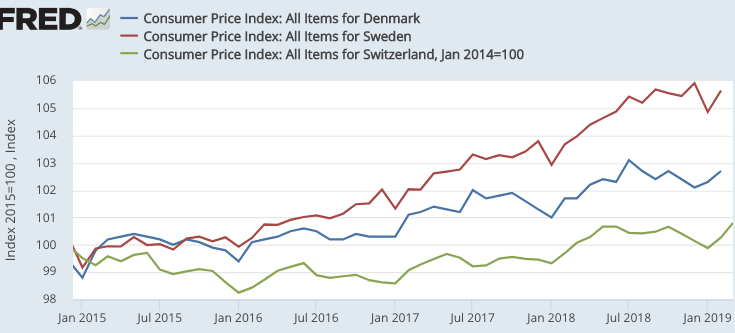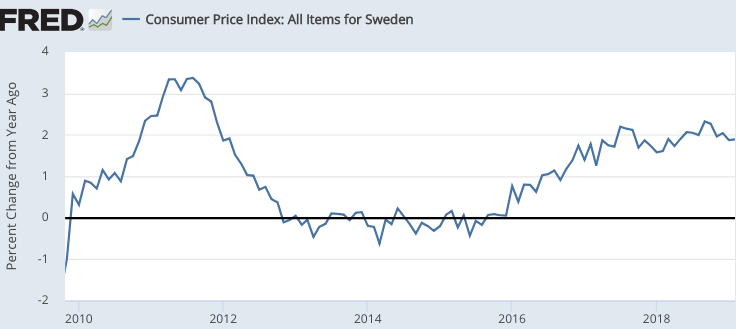I continue to see all sorts of non-monetary theories of inflation. For instance, “demographics” is often cited for the low inflation rate in Japan. There’s a much simpler explanation for inflation—monetary policy.
The following graph shows the exchange rate for three European countries, Denmark, Switzerland and Sweden:
 During this period, the Danish krone (red line) was pegged to the euro. This meant that the Danish central bank was not able to adopt an independent monetary policy. The Swiss franc was also pegged to the euro until January 2015, at which time the Swiss National bank sharply revalued the franc upwards, which shows up as a lower SF price of dollars on the graph (blue line). The Swedish Riksbank pursued a more expansionary monetary policy in order to push inflation up to their 2% target, and hence the Swedish krona (green line) depreciated substantially against the Danish krone (and also against the euro.)
During this period, the Danish krone (red line) was pegged to the euro. This meant that the Danish central bank was not able to adopt an independent monetary policy. The Swiss franc was also pegged to the euro until January 2015, at which time the Swiss National bank sharply revalued the franc upwards, which shows up as a lower SF price of dollars on the graph (blue line). The Swedish Riksbank pursued a more expansionary monetary policy in order to push inflation up to their 2% target, and hence the Swedish krona (green line) depreciated substantially against the Danish krone (and also against the euro.)
As a result of these diverging monetary policies, Sweden’s price level (red line) rose faster than the Danish price level (blue line), while Switzerland (green line) experienced an even slower rate of increase:

Of course purchasing power parity does not always hold. But in the long run, a policy that consistently depreciates a currency against another currency will generally leave the depreciating country with higher inflation.
Sweden’s expansionary monetary policy has returned its inflation rate to 2% over the past few of years, while Denmark and Switzerland continue to fall short:


READER COMMENTS
Michael Watts
May 13 2019 at 2:54pm
I think it was a very poor choice to have the first graph be blue: Switzerland, red: Denmark, green: Sweden, while the second graph is green: Switzerland, blue: Denmark, red: Sweden.
Ahmed Fares
May 13 2019 at 10:32pm
Inflation is defined as too much money chasing too few goods. Sometimes you can have too few goods which leads to money printing.
Zimbabwe broke up the large white-owned farms in the interest of social justice and distributed them in small plots to black farmers. Here was the result:
The drop-off in agricultural production is staggering. Maize farming, which yielded more than 1.5 million tons annually before 2000, is this year expected to generate just 500,000 tons. Wheat production, which stood at 309,000 tons in 2000, will hover at 27,000 tons this year. Tobacco production, too, which at 265,000 tons accounted for nearly a third of the total foreign-currency earnings in 2000, has tumbled, to about 66,000 tons in 2003. —theatlantic.com
The money printing started later. They would have still had inflation even if they printed no money.
As an aside, what would be the correct monetary policy to the above situation?
Scott Sumner
May 13 2019 at 11:51pm
Michael, Yes, consistent colors would have been better.
Ahmed, You said:
“Inflation is defined as too much money chasing too few goods.”
No, it isn’t.
And negative supply shocks don’t cause hyperinflation, unless they lead to lots of money printing.
Tom
May 14 2019 at 12:50pm
I was recently watching Yale history professor Keith Wrightson’s youtube lectures on early modern England. He discussed 15th-16th century price inflation a lot. He attributed the cause of inflation to a rising population – something like “rising population and rising prices – seems like a likely connection.” Never once did he mention the massive expansion of money supply caused by Spain’s infusion of New World silver and gold into the European economy. It made me despair about how little understood inflation is.
Michael Clifford
May 14 2019 at 6:50pm
Ahmed, inflation is not defined as “too much money chasing too few goods”. It’s a rise in the price level when more money exists than people want to hold as real balances – so, in other words, the trope you used is only accurate, in terms of MV=PY, when V and Y are stable. Both assumptions violate the short-run non-neutrality of money that monetarists and market monetarists use to explain deflationary slumps/inflationary booms.
Thomas Firey
May 15 2019 at 8:31pm
Scott: Good stuff, as usual. But Japan remains a puzzle, to me anyway. Do you have a theory? And if you do, please write a post about it, so you “have room to stretch out.”
Comments are closed.